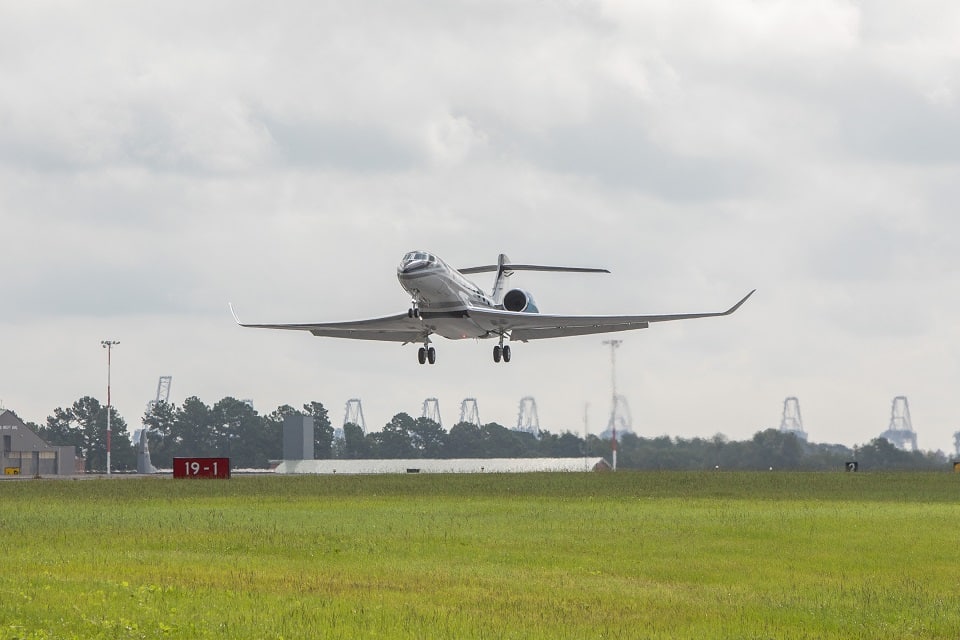Airlines
Second Gulfstream G800 test aircraft completes first flight

The second Gulfstream G800 flight test aircraft’s debut flight was announced by Gulfstream Aerospace Corp. The G800 has entered a new milestone on its way to certification and customer delivery after taking flight from Gulfstream’s Savannah headquarters using a 30/70 blend of sustainable aviation fuel.
On Saturday, July 15, at 9:27 a.m., the G800 took off. It had a flight time of 3 hours and 26 minutes, and its highest speed was Mach 0.935.
ALL-NEW GULFSTREAM G800 MAKES FIRST FLIGHT.(Opens in a new browser tab)
“Gulfstream’s flight test team continues to make advanced strides forward for our company,” stated Mark Burns, president of Gulfstream. “The G800 will offer customers around the world the longest range in the industry, and we are seeing strong demand for this capability along with the comfortable cabin and high-quality Gulfstream is known for.”
The second G800 flight test aircraft is dedicated to environmental control systems, avionics and flight controls and builds on the more than 1,600 test points already accomplished by the first G800 flight test.
Gulfstream G700 and G800 earn EASA certification(Opens in a new browser tab)
The G800 has a range of 8,000 nautical miles (14,816 km) at Mach 0.85 and 7,000 nm (12,964 km) at Mach 0.90. It also has a class-leading fuel efficiency because to its combination of the new, high-thrust Rolls-Royce Pearl 700 engines and an innovative high-speed wing and winglet built by Gulfstream. The G800 has up to four living rooms or three living areas plus a crew compartment and is designed to accommodate up to 19 passengers.

Airlines
Sanctions & Engine Issues Ground Half of Russia’s A320neo fleet

Russia’s aviation sector, already strained by Western sanctions, faces another setback as nearly half of its Airbus A320neo family aircraft are grounded due to unresolved engine issues.
This development highlights the growing challenges for russia commercial aircraft in maintaining their fleets under the weight of global restrictions and limited access to spare parts.
Out of the 66 Airbus A320neo and A321neo jets in Russia, 34 are now out of service, according to the Kommersant business newspaper. These planes are powered by engines manufactured by Pratt & Whitney, a subsidiary of RTX Corporation.
DAMAC Air: Dubai’s New Luxury Airline Offers Free Flights for Registration
The engines are affected by a previously identified defect in the metal used for certain parts, prompting accelerated inspections and maintenance.
Sanctions have compounded the issue, blocking the supply of essential components from major manufacturers like Boeing and Airbus. Without proper maintenance, experts warn that these aircraft may face decommissioning as early as 2026.
COMAC Unveils Plans for the C929 to Rival Airbus and Boeing
Airlines like S7, which operates a significant portion of these grounded jets, plan to conserve the engines for future use during peak travel seasons. However, reports suggest that over 20 of S7’s Airbus planes have engines that have already reached the end of their operational lifespan. Recently, russia seeks assistance from kazakhstan’s airlines to bolster its domestic flights.
While some A320neo and A321neo planes in Russia are equipped with French-made LEAP engines, which are seen as less problematic, the challenges remain daunting.
The situation underscores the long-term impact of sanctions on Russia’s aviation sector and the increasing difficulties in keeping its modern fleets operational.
-

 Aviation2 months ago
Aviation2 months agoMicrosoft Flight Simulator Raises $3 Million to Bring Back the An-225 Mriya
-

 Airlines2 months ago
Airlines2 months agoQantas Engineers Stage Walkout Over Cost of Living Concerns
-

 Airlines2 months ago
Airlines2 months agoQatar Citizens Can Travel to the United States Without a Visa
-

 Aviation2 months ago
Aviation2 months agoQatar Airways bans these new Electronic Devices on plane
-

 Airlines2 months ago
Airlines2 months agoJapan Airlines Rolls Out Free Domestic Flights to International Passengers
-

 Defence2 months ago
Defence2 months agoWhich Country Has the Largest Fleet of Fighter Aircraft?
-

 Airport2 months ago
Airport2 months agoWestern Sydney Airport Welcomes Its First Plane After 6 Years of construction
-

 Aviation2 months ago
Aviation2 months agoDid you know ? Once Boeing 747 carried 1088 passenger in 1991








